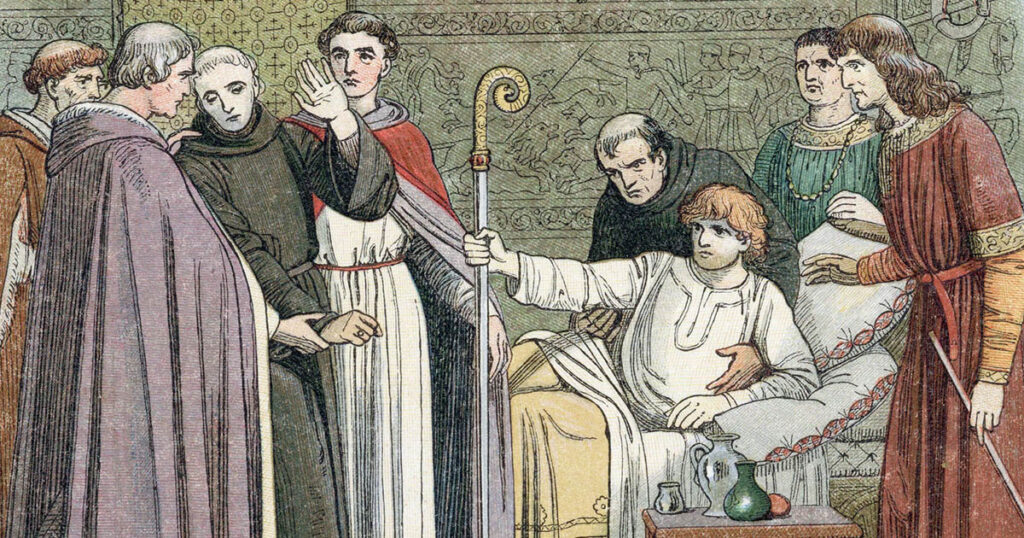I am just old enough to remember when the mid-February greeting used to run: “Happy Saint Valentine’s Day!” Anyone else remember those days?
Yes, in school we made the obligatory heart of red construction paper with glued-on fancy lace for mom. Then there was the horrid popularity contest during which certain youngsters amassed piles of store-bought valentines, and the rest of us didn’t. (Oops, did that sound bitter?)
The day was rounded out with copious cherubs brandishing bows and arrows and stomachaches occasioned by too much feasting on red, sugary hearts. Still, it was not uncommon to hear (or read): “Happy SAINT Valentine’s Day!” Not that we ever gave the saint much thought, but the greeting still reminded us that there was a little more to the day.
Fast forward to our own time, and the saint has gone completely AWOL, the day hijacked by Eros, the god of the love between the sexes (although I suppose even THAT’S up for grabs at the moment). Eros’liturgy requires giving one’s beloved a box of chocolates, perhaps a dozen red roses, and if you can swing it, a romantic dinner out (though the actual romance may be as AWOL as the saint).
In contrast, consider how the day is transformed when we remember the saint for whom it was named. Valentine was a third-century Christian and a physician. Around A.D. 270, under the reign of Claudius II in ancient Rome, Valentine laid down his life as a martyr for Christ. The red we associate with St. Valentine’s Day is a fitting reminder of the blood of all the saints and the liturgical color of the feasts of Christ’s martyrs.
We often primarily think of the martyrs as witnesses to the Christian faith, but I think that’s off. A martyr is first and foremost a witness to the divine love that is at the HEART of the Christian faith: not eros, but agape. Valentine joins the hosts of others who died to witness to the shocking love that Christ our Lord poured forth into this crazy world. He came among us in the flesh, suffered, died and rose again. He ascended on high so that He might rule His own by uniting them in saving faith to His transformative love.
St. Paul was writing about that love when he urged the congregation in Rome, the very city where Valentine would be martyred a couple of centuries later, to love those who hated them:
Bless those who persecute you; bless and do not curse them. Rejoice with those who rejoice, weep with those who weep. Live in harmony with one another. Do not be haughty, but associate with the lowly. Never be wise in your own sight. Repay no one evil for evil, but give thought to do what is honorable in the sight of all. If possible, so far as it depends on you, live peaceably with all. Beloved, never avenge yourselves, but leave it to the wrath of God, for it is written, “Vengeance is mine, I will repay, says the Lord.” To the contrary, “if your enemy is hungry, feed him; if he is thirsty, give him something to drink; for by so doing you will heap burning coals on his head.” Do not be overcome by evil, but overcome evil with good.
(Rom. 12:14–21)
People loved by God, that is the very kind of love that the church celebrates on Feb. 14: a love that shines especially for those who hate us, want to do us harm, even take away our life.
According to a later tradition, after St. Valentine was arrested for his Christian confession, he befriended his jailer’s daughter. Pitying the poor child who would miss his company, he wrote her a note of encouragement on the eve of his death. He loved that little girl, his jailer and even his executioner! How could he not? He knew that in love for him, poor sinner that he was, Jesus had given him a life of which death could never rob him.
We don’t know if the details of this story are sound, but we do know that Valentine died a martyr for Christ and that the tradition of sending notes of love and encouragement on his feast day persists.
So here’s my challenge to you: Put the “saint” back in the day. On Feb. 14, celebrate the martyr who witnessed to the love that lasts forever, the love of the crucified, risen and returning Lord! A very happy St. Valentine’s Day to one and all!
Photo: Jean-Léon Gérôme – The Christian Martyrs’ Last Prayer, Public Domain






Hello. What a great article!! I had forgotten the story of St. Valentine and why we remember him. Thank you!!
So happy to see this published to FB today. St. Valentines Day has been so appropriates for so long, people are shocked to hear the true account. Thank You!!!